Use of specific rRNA oligonucleotide probes for microscopic detection of Mycobacterium avium complex organisms in tissue
- PMID: 15814959
- PMCID: PMC1081365
- DOI: 10.1128/JCM.43.4.1505-1514.2005
Use of specific rRNA oligonucleotide probes for microscopic detection of Mycobacterium avium complex organisms in tissue
Abstract
Members of the Mycobacterium avium complex (MAC) are important environmental pathogens that are implicated in several chronic, idiopathic diseases. Diagnosis of MAC-based diseases is compromised by the need to cultivate these fastidious and slowly growing organisms in order to identify which mycobacterial species are present. Detection is particularly difficult when MAC is intracellular or embedded within mammalian tissues. We report on the development of culture-independent, in situ hybridization (ISH) assays for the detection of MAC in culture, sputum, and tissue. This assay includes a highly reliable technique for the permeabilization of mycobacterial cells within culture and tissues. We describe a set of rRNA-based oligonucleotide probes that specifically detect either M. intracellulare, the two M. avium subspecies associated with human disease, or all members of MAC. The results call into question the validity of ISH results derived by the use of other gene loci, such as IS900.
Figures
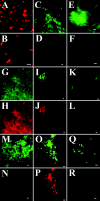
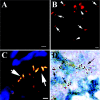
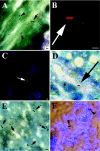
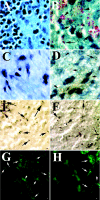
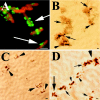
Similar articles
-
Evaluation of the accuracy and reproducibility of a practical PCR panel assay for rapid detection and differentiation of Mycobacterium avium subspecies.Mol Cell Probes. 2000 Jun;14(3):153-61. doi: 10.1006/mcpr.2000.0299. Mol Cell Probes. 2000. PMID: 10860713
-
Direct identification and discernment of Mycobacterium avium and Mycobacterium intracellulare using a real-time RNA isothermal amplification and detection method.Tuberculosis (Edinb). 2015 Dec;95(6):764-769. doi: 10.1016/j.tube.2015.07.007. Epub 2015 Aug 12. Tuberculosis (Edinb). 2015. PMID: 26316142
-
Efficient differentiation of Mycobacterium avium complex species and subspecies by use of five-target multiplex PCR.J Clin Microbiol. 2010 Nov;48(11):4057-62. doi: 10.1128/JCM.00904-10. Epub 2010 Sep 1. J Clin Microbiol. 2010. PMID: 20810779 Free PMC article.
-
[Mycobacterium avium-intracellulare complex: phenotypic and genotypic markers and the molecular basis for interspecies transmission].Bull Soc Pathol Exot. 2000 Jul;93(3):182-92. Bull Soc Pathol Exot. 2000. PMID: 11030055 Review. French.
-
Mycobacterium avium in the postgenomic era.Clin Microbiol Rev. 2007 Apr;20(2):205-29. doi: 10.1128/CMR.00036-06. Clin Microbiol Rev. 2007. PMID: 17428883 Free PMC article. Review.
Cited by
-
Epidemiological evidence for Mycobacterium avium subspecies paratuberculosis as a cause of Crohn's disease.Epidemiol Infect. 2007 Oct;135(7):1057-68. doi: 10.1017/S0950268807008448. Epub 2007 Apr 20. Epidemiol Infect. 2007. PMID: 17445316 Free PMC article. Review.
-
Evaluation of in situ methods used to detect Mycobacterium avium subsp. paratuberculosis in samples from patients with Crohn's disease.J Clin Microbiol. 2006 Aug;44(8):2942-50. doi: 10.1128/JCM.00585-06. J Clin Microbiol. 2006. PMID: 16891515 Free PMC article.
-
Use of specific rRNA oligonucleotide probes for microscopic detection of Mycobacterium tuberculosis in culture and tissue specimens.J Clin Microbiol. 2005 Oct;43(10):5369-71. doi: 10.1128/JCM.43.10.5369-5371.2005. J Clin Microbiol. 2005. PMID: 16208021 Free PMC article.
-
Dual color fluorescence in situ hybridization (FISH) assays for detecting Mycobacterium tuberculosis and Mycobacterium avium complexes and related pathogens in cultures.PLoS One. 2017 Apr 11;12(4):e0174989. doi: 10.1371/journal.pone.0174989. eCollection 2017. PLoS One. 2017. PMID: 28399124 Free PMC article.
-
The presence of mycobacterial antigens in sarcoidosis associated granulomas.Sarcoidosis Vasc Diffuse Lung Dis. 2017;34(3):236-241. doi: 10.36141/svdld.v34i3.5739. Epub 2020 Mar 9. Sarcoidosis Vasc Diffuse Lung Dis. 2017. PMID: 32476851 Free PMC article.
References
-
- Behr, M. A., M. Semret, A. Poon, and E. Schurr. 2004. Crohn's disease, mycobacteria, and NOD2. Lancet Infect. Dis. 4:136-137. - PubMed
-
- Benson, C. A. 1994. Disease due to the Mycobacterium avium complex in patients with AIDS: epidemiology and clinical syndrome. Clin. Infect. Dis. 18(Suppl. 3):S218-S222. - PubMed
-
- Bull, T. J., J. Hermon-Taylor, I. Pavlik, F. El-Zaatari, and M. Tizard. 2000. Characterization of IS900 loci in Mycobacterium avium subsp. paratuberculosis and development of multiplex PCR typing. Microbiology 146(Pt 9):2185-2197. - PubMed
-
- Bull, T. J., E. J. McMinn, K. Sidi-Boumedine, A. Skull, D. Durkin, P. Neild, G. Rhodes, R. Pickup, and J. Hermon-Taylor. 2003. Detection and verification of Mycobacterium avium subsp. paratuberculosis in fresh ileocolonic mucosal biopsy specimens from individuals with and without Crohn's disease. J. Clin. Microbiol. 41:2915-2923. - PMC - PubMed
Publication types
MeSH terms
Substances
LinkOut - more resources
Full Text Sources
Other Literature Sources
Miscellaneous

